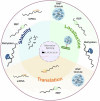Regulating translation in aging: from global to gene-specific mechanisms
- PMID: 39562712
- PMCID: PMC11624266
- DOI: 10.1038/s44319-024-00315-2
Regulating translation in aging: from global to gene-specific mechanisms
Abstract
Aging is characterized by a decline in various biological functions that is associated with changes in gene expression programs. Recent transcriptome-wide integrative studies in diverse organisms and tissues have revealed a gradual uncoupling between RNA and protein levels with aging, which highlights the importance of post-transcriptional regulatory processes. Here, we provide an overview of multi-omics analyses that show the progressive uncorrelation of transcriptomes and proteomes during the course of healthy aging. We then describe the molecular changes leading to global downregulation of protein synthesis with age and review recent work dissecting the mechanisms involved in gene-specific translational regulation in complementary model organisms. These mechanisms include the recognition of regulated mRNAs by trans-acting factors such as miRNA and RNA-binding proteins, the condensation of mRNAs into repressive cytoplasmic RNP granules, and the pausing of ribosomes at specific residues. Lastly, we mention future challenges of this emerging field, possible buffering functions as well as potential links with disease.
Keywords: Aging; Post-transcriptional Regulation; RNA; RNA-Binding Proteins; Tanslation.
© 2024. The Author(s).
Conflict of interest statement
Disclosure and competing interests statement. The authors declare no competing interests.
Figures



Similar articles
-
Dynamic Field Theory of Executive Function: Identifying Early Neurocognitive Markers.Monogr Soc Res Child Dev. 2024 Dec;89(3):7-109. doi: 10.1111/mono.12478. Monogr Soc Res Child Dev. 2024. PMID: 39628288 Free PMC article.
-
Depressing time: Waiting, melancholia, and the psychoanalytic practice of care.In: Kirtsoglou E, Simpson B, editors. The Time of Anthropology: Studies of Contemporary Chronopolitics. Abingdon: Routledge; 2020. Chapter 5. In: Kirtsoglou E, Simpson B, editors. The Time of Anthropology: Studies of Contemporary Chronopolitics. Abingdon: Routledge; 2020. Chapter 5. PMID: 36137063 Free Books & Documents. Review.
-
Comparison of Two Modern Survival Prediction Tools, SORG-MLA and METSSS, in Patients With Symptomatic Long-bone Metastases Who Underwent Local Treatment With Surgery Followed by Radiotherapy and With Radiotherapy Alone.Clin Orthop Relat Res. 2024 Dec 1;482(12):2193-2208. doi: 10.1097/CORR.0000000000003185. Epub 2024 Jul 23. Clin Orthop Relat Res. 2024. PMID: 39051924
-
Qualitative evidence synthesis informing our understanding of people's perceptions and experiences of targeted digital communication.Cochrane Database Syst Rev. 2019 Oct 23;10(10):ED000141. doi: 10.1002/14651858.ED000141. Cochrane Database Syst Rev. 2019. PMID: 31643081 Free PMC article.
-
Platelet-rich therapies for musculoskeletal soft tissue injuries.Cochrane Database Syst Rev. 2014 Apr 29;2014(4):CD010071. doi: 10.1002/14651858.CD010071.pub3. Cochrane Database Syst Rev. 2014. PMID: 24782334 Free PMC article. Review.
References
-
- Adekunle DA, Hubstenberger A (2020) The multiscale and multiphase organization of the transcriptome. Emerg Top Life Sci 4:265–280 - PubMed
-
- Alberti S, Hyman AA (2021) Biomolecular condensates at the nexus of cellular stress, protein aggregation disease and ageing. Nat Rev Mol Cell Biol 22:196–213 - PubMed
-
- An H, de Meritens CR, Shelkovnikova TA (2021) Connecting the “dots”: RNP granule network in health and disease. Biochim Biophys Acta Mol Cell Res 1868:119058 - PubMed
Publication types
MeSH terms
Substances
Grants and funding
LinkOut - more resources
Full Text Sources
Medical

